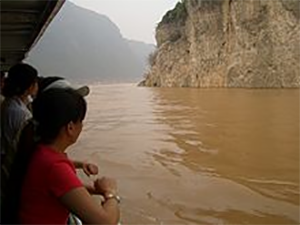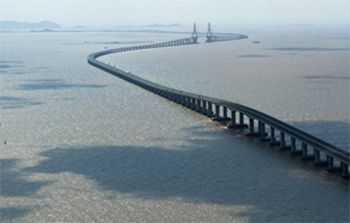InTrans / Mar 15, 2015
Main modes of transportation: DESTINATION CHINA
Go! Magazine
 posted on March 20, 2015
posted on March 20, 2015
Did you know that China is nearly the same size as the United States? But did you know that its population exceeds that of the US by over one billion?
Because of the high density of people, including China’s largest city of Shanghai with over 23 million people, China has put a lot of funds towards creating efficient modes of transportation. Between 2006 and 2010, it is estimated that $200 billion was spent on railways alone. Today, China’s main mode of transportation is railways, which carry both freight and passengers.
When thinking about transportation, one thing to consideration is the geography of the country. China has three geographic regions, which includes the west (identified as mountainous), the northeast (identified as primarily desert with basin-like features), and the valleys and plains to the east.
The geography and density of people in a particular location could determine the most popular (or available) transportation modes. For example, bikes are still fairly popular in rural areas, whereas bikes are losing popularity to cars and high-speed trains in more urban regions of China.
Inside China: Then and now
Passenger boats
China has more navigable rivers, streams, lakes and canals than anywhere else in the world, totaling over 68,350 miles. To put that into perspective, the diameter of the Earth is only 7,918 miles!

With an increase in railways and roads, there has been less incentive for people to travel by boat. In some areas, like western mountainous regions that do not have as many railways and roads, passenger boats are still found to be a convenient mode of travel.
In 2003, there were 6.3 trillion passenger/kilometers moving through China by water alone. You may be wondering, “Wow, that’s a lot of people moving by water!” To help us understand that number, let’s use an example. If 10 people on a boat travel 10 kilometers, then that would equal 100 passenger kilometers. Passenger boats can carry around 300 people, so it’s no wonder why the passenger kilometers are so high!
Bikes
Before 1980, Beijing, China, was said to have more than nine million bicycles in the city. However, as cars began to gain popularity in the middle and upper classes in China in the 1980s, bicycles became a symbol of the lower class. In a report from the Earth Policy Institute, researchers reported that from 1995 to 2005 China’s bicycle users dropped from 670 million to 435 million, or 35 percent. At the same time, car ownership doubled.
Some of this decline is not just due to cars becoming a symbol of lower class, but also from the government blaming bicyclists for increased accidents. In Shanghai, bicycles were banned from certain downtown roads in 2004.
However, the 2010 62-mile, nine-day traffic jam caused the government to reconsider their transportation priorities. Now, to try and revive the bicycling culture, Hangzhou, China, has started the world’s largest bike share program. Hangzhou, which is 100 miles from Shanghai, currently has over 60,000 bikes in the bike share program and is planning to total 175,000 bikes by 2020.
High-speed rail and Maglev Train
As of 2010, China had over 4,340 high speed rail lines. And nine of these rail lines are capable of traveling over 185 miles/hour. The network of these high speed railways was first introduced in 2007. In total, China has over 12,000 existing miles of high speed rail, with another 10,100 miles under construction. To put this into perspective, Spain, which has the second largest number of rail miles, has only 1,900 miles of existing high speed rails.
China was first in the world to have a high-speed Maglev Train, which is a train that moves via magnetic levitation. The cost of this train was about $1.2 billion.
Building Roads
Beginning with the communist rule in China, which was founded in 1921, the government initiated a huge effort to start building highways across the country.

China has over 80,000 miles of highway miles, which makes it the longest interstate highway system in the world. Today, highways and motor vehicles carry more than 13.5 percent of cargo and almost 50 percent of passengers, which continues to rise.
Why do modes of transportation matter?
The mode of transportation people take matters a lot. The social, environmental, and economic impacts of driving versus bicycling, for example, are much different. By having more bicyclists on the road rather than drivers, air pollution is cut down, and people’s health from physical activity is greatly improved. Driving, on the other hand, has allowed us to travel further distances in less time.
There are implications for every mode of travel. Some impacts are more positive than others, making it important to keep a diversity of travel modes available to people.
Related links
http://thediplomat.com/2014/11/the-new-silk-road-chinas-marshall-plan/
http://thediplomat.com/2014/05/chinas-new-silk-road-vision-revealed/
http://en.wikipedia.org/wiki/Transport_in_China
By Jackie Nester, Go! Staff Writer